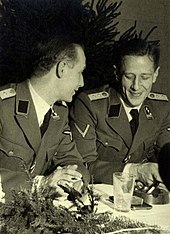Central Office for Jewish Emigration in Amsterdam
The Central Office for Jewish Emigration in Amsterdam was established at the end of March 1941 based on the concept of the Central Office for Jewish Emigration in Vienna . It was housed in a building on van Eeghenstraat in Amsterdam . The tasks of the central office initially included accelerating the forced emigration of Jews from the Netherlands . Later the central office also functioned as an executive body for "Jewish affairs" up to the organization of deportations to the extermination camps .
tasks
The task of the central office was initially to accelerate the compulsory emigration of Jews in the Netherlands and the Jewish refugees there. In the central office, all measures relating to departure were coordinated, such as questions of citizenship , property taxes, foreign exchange and the issuing and viewing of all necessary documents. By May 1941, however, only 200 emigration procedures had been carried out, after which emigration of Jews from the Netherlands was prohibited with a few exceptions.
However, the comprehensive competencies for the central office to be set up, which the Higher SS and Police Leader of the occupied Netherlands Hanns Albin Rauter had requested in writing from Reich Commissioner Arthur Seyß-Inquart , were not approved by Seyß-Inquart. Seyß-Inquart feared that the Sipo would be given too far-reaching powers across the police force. In contrast to the Vienna and Prague Central Office, the Central Office for Jewish Emigration in Amsterdam did not have an emigration fund attached. These funds, in which Jewish assets, foreign currency and real estate were administered, were also intended to finance the emigration of the Jewish victims themselves. This institution was instead entrusted to the General Commissioner for Finance and Economy.
After the central office was mainly concerned with the registration of Jews in the Netherlands after the emigration ban until autumn 1941, the task of the central office was specified by the commander of the security police and the SD (BdS) in the Netherlands Wilhelm Harster on August 28, 1941 :
“The Central Office for Jewish Emigration Amsterdam is responsible for the smuggling of Jews through as a preliminary measure for the upcoming resettlement and the technical handling of emigration applications. (I have reserved the right to issue special permits for emigration.) The Central Office for Jewish Emigration in Amsterdam is being expanded to become the only command issuing office for the Jewish Council . I will assign further tasks to her in the course of the development. "

After the Wannsee Conference , on February 3, 1942, Harster ordered the "preparation of the final solution " with regard to the task of the central office :
"A) I have given the Central Office for Jewish Emigration:
- 1. The control of Jewish life:
(Issuing orders to the Judenrat, Jewish organizations, training, welfare, work , weekly paper).
- 2. The implementation of the order on the appearance of Jews in public:
(Determination of local and temporal restrictions in detail, monitoring of labeling, admission to public facilities and events, relocation permits).
- 3. The preparation of the final solution:
(Through the Central Office for Jewish Emigration, resettlement campaigns, Westerbork camp , preparation for resettlement). "
Euphemisms such as resettlement or resettlement served as cover-up terms for the Holocaust . The Judenrat in Amsterdam , set up by Seyß-Inquart in February 1941 , headed by David Cohen and Abraham Asscher , was forced to be a cooperation partner and the central point of contact for the Central Office with regard to “Jewish affairs”. The central office was now the link between the BdS and the Judenrat and thus became the central organization for the deportations of Jews.
As early as July 5, 1942, the Central Office asked 4,000 Jews to come to the Westerbork transit camp immediately for a health check for a work assignment in Germany . While the Central Office initiated the deportations, the Department for Jews at the BdS was responsible for enforcing the deportations. The transports continued from the Westerbork transit camp to the extermination camp.
In September 1941, 140,000 Jews were registered in the Netherlands, including German and Austrian refugees. Of the 107,000 deported Jews, only 5,200 survived the Holocaust.
Structure and staff

The central offices in Vienna and Amsterdam as well as the central office for Jewish emigration in Prague , established in July 1939, were branch offices of the Reich Central Office for Jewish Emigration in Berlin .
After it was founded in April 1941, the central office in Amsterdam initially only had a dozen employees. It was headed by Klaus Barbie and SS Unterführer Günter Rahm, then by Government Councilor Reinhardt. From September / October 1941 the ZJA was expanded. Now the supervision was with the head of the BdS branch in Amsterdam, SS-Sturmbannführer Willy Lages . When Reinhardt was transferred, Ferdinand from Fünten first took over the treasury and later also the administration.
Around 100 people were now employed in the central office. Among them were about twelve German police officers who worked together with Dutch colleagues in a research department, about 20 German and Dutch employees of the "Department of Travel and Relocation Permits" and about 70 Dutch employees of the "Household items registration" department.
Because the ZJA was subordinate to the BdS, the Eichmann department could not directly influence this central office.
literature
- Mathias Middelberg : Jewish law, Jewish policy and the lawyer Hans Calmeyer in the occupied Netherlands 1940–1945. V&R Unipress GmbH, Göttingen 2005, ISBN 3-89971-123-8 ( Osnabrücker Schriften zur Rechtsgeschichte 5), (At the same time: Osnabrück, Univ., Diss., 2002-2003).
- Independent Commission of Experts Switzerland - Second World War (Ed.): Switzerland and the German ransom extortions in the occupied Netherlands. Deprivation of property, ransom, exchange 1940–1945. Supplement to the report Switzerland and the refugees at the time of National Socialism . BBL / EDMZ et al., Bern 1999, ISBN 3-908661-09-9 (pdf; 865 KB) .
Individual evidence
- ^ A b c Mathias Middelberg: Jewish law, Jewish policy and the lawyer Hans Calmeyer in the occupied Netherlands 1940-1945. V&R Unipress GmbH, Göttingen 2005, ISBN 3-89971-123-8 , p. 127ff.
- ↑ Rauter on April 18, 1941 in writing to Seyß-Inquart regarding the establishment of a central office for Jewish emigration in Amsterdam, justice and Nazi crimes - Volume XXV, current no. 645 ( Memento of April 29, 2005 in the Internet Archive ), p. 2.
- ^ Christoph Kreutzmüller: Dealers and sales assistants. The Amsterdam financial center and the major German banks (1918–1945). Franz Steiner Verlag, Stuttgart 2005, ISBN 3-515-08639-0 , p. 142.
- ↑ Document VEJ 5/89 in: Katja Happe, Michael Mayer, Maja Peers (edit.): The persecution and murder of European Jews by National Socialist Germany 1933–1945 (source collection) Volume 5: Western and Northern Europe 1940– June 1942. Munich 2012, ISBN 978-3-486-58682-4 , here p. 270 / Wilhelm Harster in writing on “Distribution of business in the field of the Jewish question” on August 21, 1941. Quoted in: Justice and Nazi Crimes - Volume XXV, Current No. . 645 ( Memento of August 27, 2006 in the Internet Archive ), p. 3.
- ↑ Wilhelm Harster in writing on “Competence in Jewish Issues” on February 3, 1942, cited in: Justiz und NS-Verbrechen - Volume XXV, serial no. 645 ( Memento of August 27, 2006 in the Internet Archive ), p. 4.
- ^ Sandra Ziegler: Memory and Identity of the Concentration Camp Experience. Dutch and German eyewitness accounts of the Holocaust. Königshausen & Neumann, Würzburg 2006, ISBN 3-8260-3084-2 , pp. 123, 139.
- ↑ Independent Expert Commission Switzerland - Second World War (Ed.), Pp. 35, 50.
- ^ Johannes Houwink Ten Cate: The commander of the Sipo and the SD in the occupied Dutch territories and the deportation of the Jews 1942-1943. In Wolfgang Benz ; Joannes Houwink Ten Cate; Gerhard Otto: The bureaucracy of the occupation. Structures of rule and administration in occupied Europe. Berlin 1998, ISBN 3-932482-04-2 . P. 208f.
- ↑ Gabriele Anderl, Dirk Rupnow, Alexandra-Eileen Wenck, Historians Commission of the Republic of Austria: The Central Office for Jewish Emigration as a Robbery Institution. Oldenbourg Wissenschaftsverlag, Vienna et al. 2004, ISBN 3-7029-0497-2 , p. 313.
